May was another big month for new replicated features! Based on input from vendors like you, we have some exciting new capabilities to share. Remember, we build these tools so you don't have to!
Here is a list of what's now available in our vendor portal, application manager (building on the open source “KOTS” project AKA Kubernetes Off-The-Shelf), and our Kubernetes installer (expanding on “kURL”.)
What’s New for the vendor portal
- Vendor portal: See the history of Kubernetes installers promoted to a channel
- Vendor portal: Preview the application icon while creating a release
- Vendor portal: Improved filtering on the Customers page
- Vendor portal: Redesigned application dropdown
What’s New for the application manager
- Application manager: Control Native Helm chart installation order with the new ‘weight’ attribute
What’s New for the Kubernetes installer
- Kubernetes installer: New AWS add-on to integrate K8s and AWS
What’s New for the replicated documentation
- replicated Documentation: Improved GitOps Content
- replicated Documentation: Customizing the Configuration Screen
- replicated Documentation: Adding Helm Charts to a Release
What’s New for the vendor portal
Vendor portal: See the history of Kubernetes installers promoted to a channel
Although it was possible in the vendor portal to see the history of releases promoted to a channel, no such history was available for the Kubernetes installer. Vendors could only see which Kubernetes installer was currently promoted to the channel, making it impossible to use or see earlier installers without remembering them independently.
Now, clicking the Installer history link on a channel card shows the list of Kubernetes installers that have been promoted to the channel over time. For each installer, vendors can also see the installer version label (if it was provided), as well as a command to use that particular installer.
Click the Installer history link on the channel card to check it out, and start using version labels for installers in order to more easily identify them.
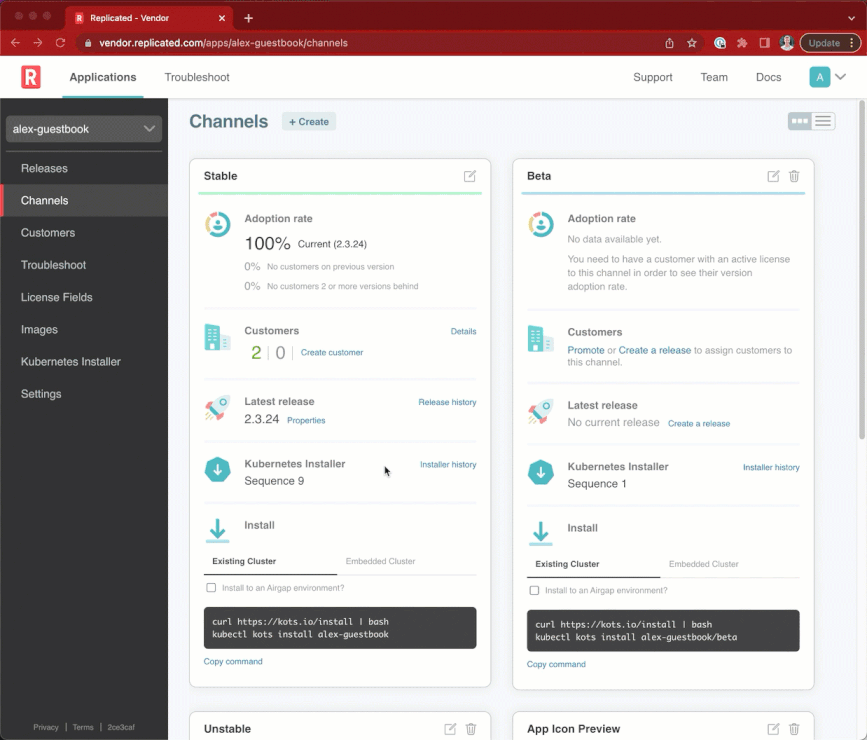
Vendor portal: Preview the application icon while creating a release
There was previously no way to see what an application icon would look like without saving and promoting a release and then either accessing the download portal or deploying an admin console. Now, while creating a release, vendors can dynamically see what an icon will look like using the new application icon preview, located in the help menu on the right side of the file editor. The application icon preview currently only appears when viewing a kots.io/v1beta1 Application resource.
If the icon field is already populated, then the icon preview will show what it will look like once promoted. Vendors can also upload new images for preview or use a link or data URL in order to preview an image before adding it to their Application spec. While previewing an icon, vendors can also now generate Base64-encoded data URLs to use for air gap deployments.
Vendors should make sure their icon is displaying properly by checking out this icon preview, and use it to iterate on new icons (as needed) for their application.
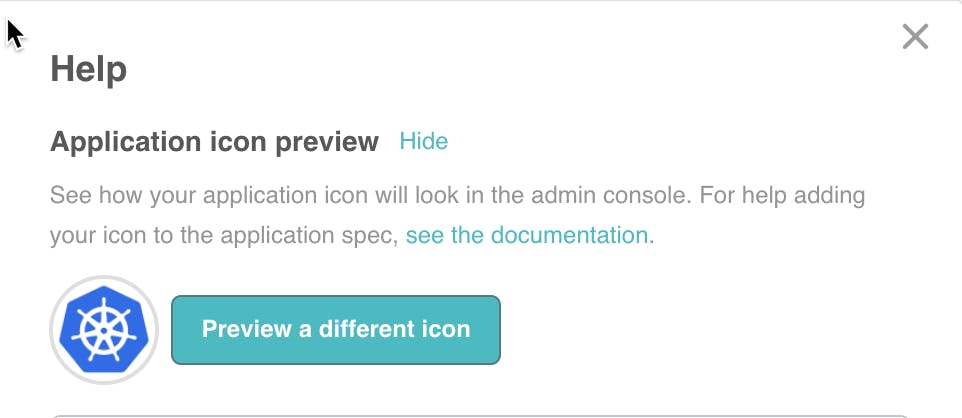
Vendor portal: Improved filtering on the Customers page
Initially, we set out to update the channel cards so that clicking the Details link next to Customers would direct to a filtered view of customers assigned to that channel. This led us to significantly improve customer filtering in general. We added visual identifiers for the applied filters, so that it’s easy to see whether and which filters are applied. We redesigned the filters themselves for ease of use, so that, for example, selecting Customers from the left menu leads to an unfiltered view, rather than a view with some filters already applied. Finally, filters and things like page size are now part of the URL, so that a link to a filtered view of customers can be shared.
Vendors can check out the new filtering to easily find the customers they want to see.
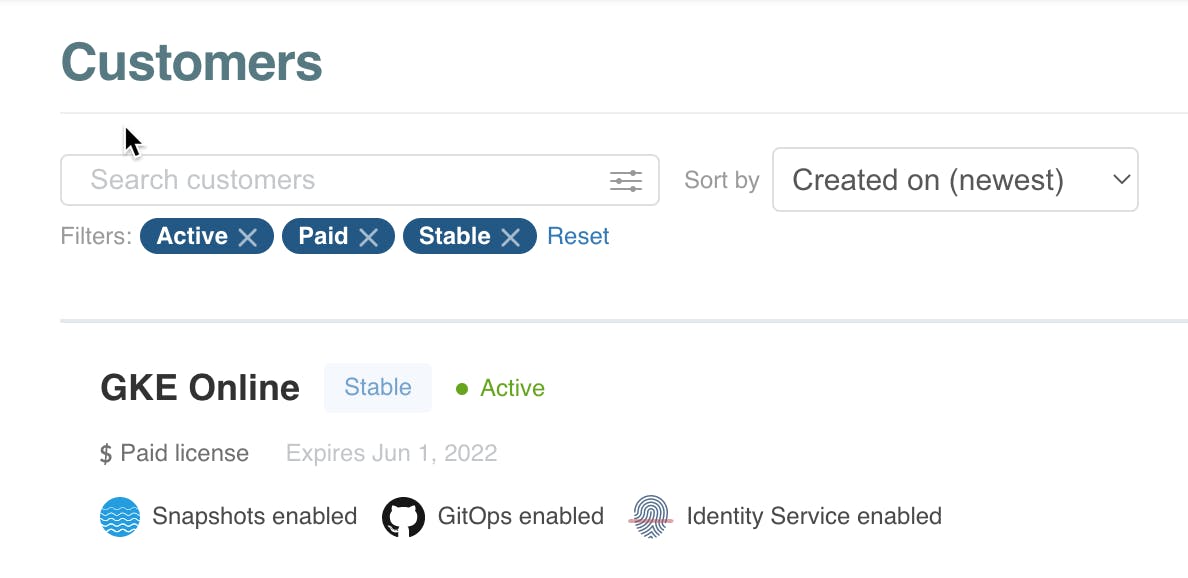
Vendor portal: Redesigned application dropdown menu
The application dropdown menu in the vendor portal has been redesigned both aesthetically and to improve functionality for teams with more than one application. In addition to aesthetic changes, the dropdown now provides an auto-focused search box, so that vendors can start typing to find their desired application. The dropdown also remembers the last application that was accessed, instead of always showing the first app alphabetically. This way, vendors who often use one particular application won’t need to always select that app again when returning to the vendor portal.
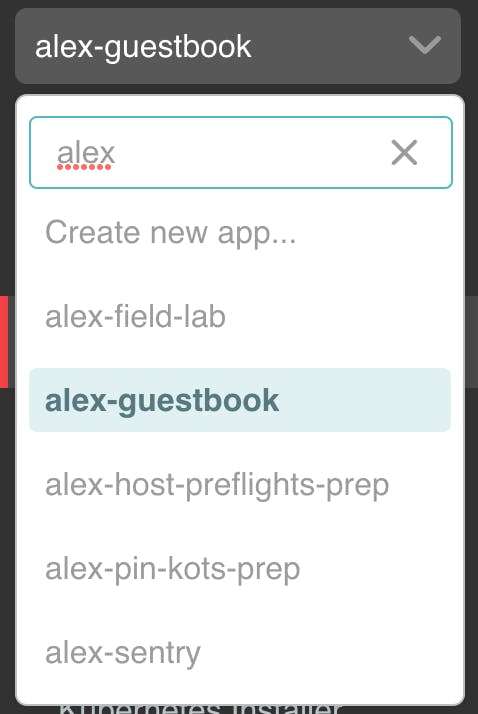
What’s New for the application manager
Application manager: Control Native Helm chart installation order with the new ‘weight’ attribute
To further expand our Native Helm installation feature, our team had received feedback from several users that were looking for additional alternatives to control the Helm chart installation order from app manager and outside of the flow control mechanisms provided within a single Helm chart itself. The focus of this was to have a means to control the order in which Helm chart install commands were run by the application manager on however many charts, including any subcharts therein, that may be needed to deploy their application. To control this, replicated has added a new attribute available in the HelmChart CRD. When installing with native helm, app manager will take cue from the weight as it is configured in the HelmChart CRD. This allows users to specify different weights which will control the order for each Helm chart to be installed in ascending order from lowest to highest.
Application manager: Change password workflow
Historically, the only way to change the password for logging into the application manager was via the KOTS CLI tool. Though useful, there was an opportunity to improve this experience by making it easier and more discoverable. From version 1.70.0 and beyond, logged in users can now change the password from directly within the application manager. Once the password change is successful, the user is logged out and must log back in to reestablish a session. You can see this in the brief video below.
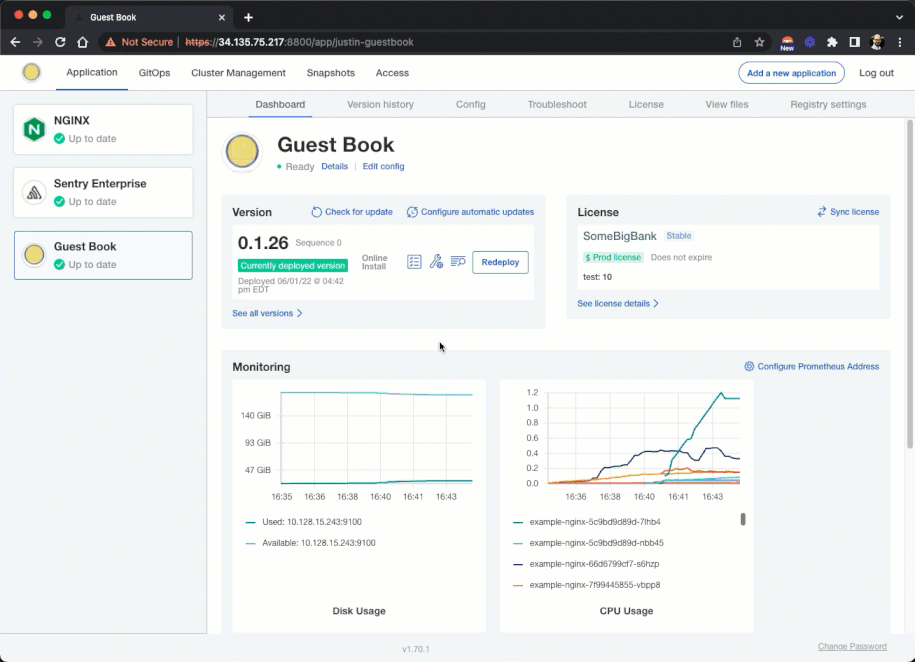
Additionally, those that are looking to change their password more frequently, want per-use audit logging, or have other more advanced credential-related requirements may want to consider exploring the current beta feature for using an identity provider for logging in to the application manager. When enabled, this feature will off-load the credential management for logging into app manager to whichever OpenID provider that is configured. Additionally, vendors can also extend this into their applications too. Please feel free to reach out to your contacts at replicated if you are interested in using or have feedback on this feature!
What’s New for the Kubernetes installer
Kubernetes installer: New AWS add-on to integrate K8s and AWS
The new AWS add-on is based off of the open source AWS Cloud Provider for Kubernetes. This project is used to power kURL installations to configure Kubernetes to directly interface with Amazon APIs. This extends automation from Kubernetes directly into Amazon and helps users defer things like resource usage and management to specific Amazon services. By using this add-on, vendors and their customers can leverage Amazon resources directly instead of fulfilling these roles with other add-ons. A few examples of the functionality include:
- Provisioning volumes from Elastic Block Store (EBS) instead of using a volume provisioner add-on
- Dynamic management of Elastic Load Balancers (ELB) for exposing Kubernetes service objects
- Retrieving images from Elastic Container Registry (ECR)

What’s New for the replicated documentation
replicated Documentation: Improved GitOps Content
Previously, the GitOps topics were not task-based, and were presented as two topics: one for single-app and one for multi-app. The GitOps documentation was condensed into one topic that is an easy-to-follow procedure. Content additions have been made that capture helpful information, such as the Prerequisites that GitOps requires, so that enterprise customers can get up and running quickly.
replicated Documentation: Customizing the Configuration Screen
The Configuration screen in the replicated admin console is customized using the Config custom resource. We added a Customizing the Configuration Screen section in the vendor docs that includes detailed information about these features. We also added new procedures that explain how to add fields to the configuration screen, and then map the user-supplied values to either standard manifests or Helm charts.
replicated Documentation: Adding Helm Charts to a Release
A new Adding Helm Charts to a Release topic describes how to package a Helm chart as a .tgz then use the vendor portal or the replicated CLI to add it to a release. It includes details about the HelmChart custom resources as well as some recommended next steps after you add a Helm chart.
replicated Documentation: Uninstalling the kots CLI
For customers who want to uninstall the kots CLI to do a completely fresh installation, a procedure for uninstalling the kots CLI was added to the kots CLI Reference documentation.
See? We told you it was a busy month at replicated! Want to learn more about these new features and what replicated does to help vendors and customers install and manage modern apps on-prem?
We would love to show you -- click here to schedule a demo.